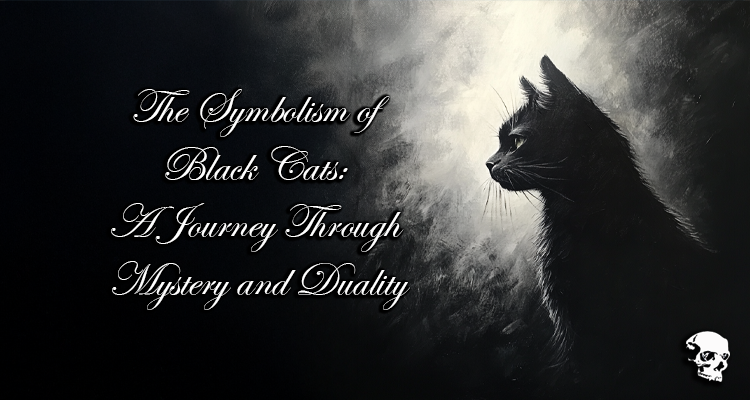Currently Empty: $0.00

The Symbolism of Black Cats: A Journey Through Mystery and Duality
Duality in Symbolism: Protectors and Harbingers
The symbolism of black cats is steeped in paradox. In Slavic folklore, they are both revered and feared, embodying the dual forces of light and dark. On one hand, they are seen as guardians of homes and cattle, warding off malevolent spirits and safeguarding families. On the other hand, their association with witchcraft and death places them within the realm of the supernatural.
This duality reflects humanity’s deep fascination with creatures that defy easy categorization. Black cats evoke a tension between their role as protectors and their connection to the unknown. For those who embrace the mysterious, black cats symbolize a balance between the tangible and the mystical—a bridge between worlds. The contradictions inherent in these beliefs highlight their enduring place in folklore, where they represent both comfort and unease, order and chaos.
Black Cats, Magic, and the Mysteries of Death
Across many cultures, black cats are tightly bound to themes of magic, authority, and the afterlife. In Chinese and Russian mythology, their dark hue symbolizes mystery, power, and mortality. These associations align with practices like ancestor worship, where black cats are believed to act as mediators between the living and the spirit world.
This connection to the magical and supernatural lends black cats an air of reverence. To some, their presence signals a link to unseen forces, a reminder of the thin veil separating this world from the next. At the same time, their association with death can evoke fear, casting them as omens of ill fortune. For those who see beauty in the arcane, however, black cats represent an invitation to explore the shadowy recesses of existence. They embody the allure of the unknown—a quality both unsettling and irresistible.
Christianity and the Demonization of Black Cats
The European Middle Ages saw a dramatic shift in the perception of black cats, largely influenced by Christian doctrine. During this period, black cats became synonymous with witches and the occult, culminating in widespread superstition and fear. Their nocturnal nature and elusive demeanor were viewed as evidence of their ties to demonic forces.
This negative portrayal was reinforced by the Church, which sought to suppress pagan practices and beliefs. Black cats, often linked to pre-Christian goddess worship, were recast as symbols of heresy and evil. The result was a tragic history of persecution, with black cats being hunted as agents of misfortune.
However, this association with witchcraft and rebellion also gave black cats an intriguing edge. For those outside the mainstream, black cats became symbols of defiance, embodying the spirit of resistance against oppressive ideologies. Today, this historical baggage lends them an aura of rebellion, aligning them with those who dare to challenge convention and embrace their own path.
The Literary Black Cat: A Symbol of Guilt and the Supernatural
In literature, black cats have long been used as metaphors for humanity’s darker impulses. Edgar Allan Poe’s The Black Cat is a prime example, exploring themes of guilt, violence, and moral decay. The cat in Poe’s tale transcends its physical form, becoming a spectral force that mirrors the narrator’s psychological torment.
This literary use of black cats taps into their symbolic power as creatures of mystery and consequence. They are not merely animals but harbingers of deeper truths, their presence amplifying the tension between reality and the supernatural. For readers drawn to the gothic and the macabre, black cats serve as potent reminders of the complexities of human nature. They challenge us to confront our fears, our flaws, and the shadows that lurk within.
Black Cats as Symbols of Resistance and Empowerment
Despite their often grim associations, black cats have also been reimagined as symbols of strength and defiance. Their marginalization in folklore parallels broader struggles against prejudice and otherness. In Greek folklore, for example, black cats are celebrated as survivors, their resilience mirroring the endurance of marginalized communities.
This reframing of black cats as symbols of empowerment highlights their ability to transcend their negative connotations. By embracing their mystery and independence, they offer a powerful metaphor for those who refuse to conform. For those who identify with the beauty of being misunderstood, black cats stand as symbols of pride and individuality.
Shadows and Light: The Enduring Legacy of Black Cats
The symbolism of black cats continues to captivate, offering a rich tapestry of meanings that reflect humanity’s deepest fears and desires. Whether seen as protectors, omens, or rebels, black cats embody the complexities of life’s dualities—light and dark, good and evil, seen and unseen.
Their role in folklore reminds us of the power of perception and the beauty of embracing the unknown. For those who find solace in the shadows, black cats remain timeless icons, their silent presence a reminder of life’s mysteries waiting to be unraveled.
Are you enjoying this article or our site? Love of Gothic and the Dark Matters & Mischief magazine are run by dedicated volunteers, and we rely on crowdfunding to cover our expenses. Your support is crucial to keep us going! Consider becoming a paying member of our Patreon or purchasing something from our shop to help us continue providing content and community support. Thank you for your support!

